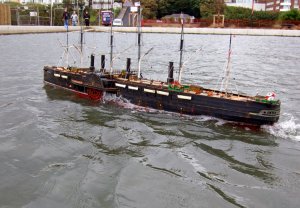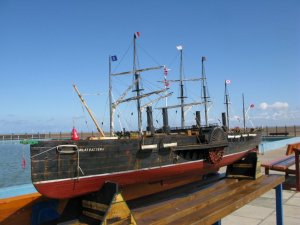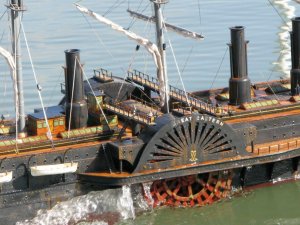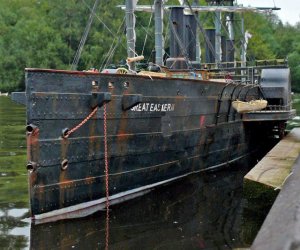SS Great Eastern was an iron sailing steamship designed by Isambard Kingdom Brunel, and built by J. Scott Russell & Co. at Millwall Iron Works on the River Thames, London. She was by far the largest ship ever built at the time of her 1858 launch, and had the capacity to carry 4,000 passengers from England to Australia without refuelling.
Her length of 692 feet or 211 m was only surpassed in 1899 by the 705-foot (215 m) 17,274-gross-ton RMS Oceanic,
and her gross tonnage of 18,915 was only surpassed in 1901 by the 701-foot (214 m) 21,035-gross-ton RMS Celtic.
The ship's five funnels were rare. These were later reduced to four.
Brunel knew her affectionately as the "Great Babe". He died in 1859 shortly after her ill-fated maiden voyage, during which she was damaged by an explosion. After repairs, she plied for several years as a passenger liner between Britain and North America before being converted to a cable-laying ship and laying the first lasting transatlantic telegraph cable in 1866.[4] Finishing her life as a floating music hall and advertising hoarding (for the famous department store Lewis's) in Liverpool, she was broken up on Merseyside in 1889.
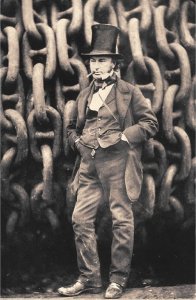
The famous Robert Howlett photo of Isambard Kingdom Brunel against the launching chains of Great Eastern at Millwall in 1857.

size comparison of the Brunel´s Ships
Concept
After his success in pioneering steam travel to North America with Great Western and Great Britain, Brunel turned his attention to longer voyages as far as Australia and realised the potential of a ship that could travel round the world without the need of refuelling.
On 25 March 1852, Brunel made a sketch of a steamship in his diary and wrote beneath it: "Say 600 ft x 65 ft x 30 ft" (180 m x 20 m x 9.1 m). These measurements were six times larger by volume than any ship afloat; such a large vessel would benefit from economies of scale and would be both fast and economical, requiring fewer crew than the equivalent tonnage made up of smaller ships. Brunel realised that the ship would need more than one propulsion system; since twin screws were still very much experimental, he settled on a combination of a single screw and paddle wheels, with auxiliary sail power. Using paddle wheels meant that the ship would be able to reach Calcutta, where the Hooghly River was too shallow for screws.
Brunel showed his idea to John Scott Russell, an experienced naval architect and ship builder whom he had first met at the Great Exhibition. Scott Russell examined Brunel's plan and made his own calculations as to the ship's feasibility. He calculated that it would have a displacement of 20,000 tons and would require 8,500 horsepower (6,300 kW) to achieve 14 knots (26 km/h), but believed it was possible. At Scott Russell's suggestion, they approached the directors of the Eastern Steam Navigation Company.
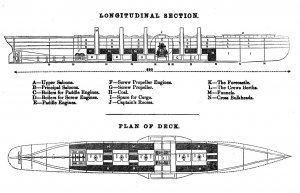
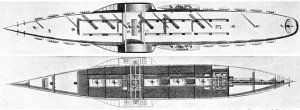
Sectional plan of Great Eastern
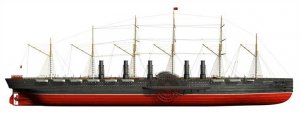
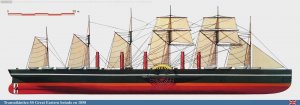
1854–1859: Construction to maiden voyage
Although Brunel had estimated the cost of building the ship at £500,000, Scott Russell offered a very low tender of £377,200: £275,200 for the hull, £60,000 for the screw engines and boilers, and £42,000 for the paddle engines and boilers. Scott Russell even offered to reduce the tender to £258,000 if an order for a sister ship was placed at the same time. Brunel accepted Scott Russell's tender in May 1853, without questioning it; Scott Russell was a highly skilled shipbuilder and Brunel would accept an estimate from such an esteemed colleague without question.
In the spring of 1854 work could at last begin. The first problem to arise was where the ship was to be built. Scott Russell's contract stipulated that it was to be built in a dock, but Russell quoted a price of £8–10,000 to build the necessary dock and so this part of the scheme was abandoned, partly due to the cost and also to the difficulty of finding a suitable site for the dock. The idea of a normal stern first launch was also rejected because of the great length of the vessel, also because to provide the right launch angle the bow of the ship would have to be raised 40 feet (12 m) in the air. Eventually it was decided to build the ship sideways to the river and use a mechanical slip designed by Brunel for the launch. Later the mechanical design was dropped on the grounds of cost, although the sideways plan remained.
Having decided on a sideways launch, a suitable site had to be found, as Scott Russell's Millwall, London, yard was too small. The adjacent yard belonging to David Napier was empty, available and suitable, so it was leased and a railway line constructed between the two yards for moving materials. The site of the launch is still visible on the Isle of Dogs. Part of the slipway has been preserved on the waterfront, while at low tide, more of the slipway can be seen on the Thames foreshore. The remains of the slipways, and other structures associated with the launch of the SS Great Eastern, have recently been surveyed by the Thames Discovery Programme, a community project recording the archaeology of the Thames intertidal zone in London.
Great Eastern's keel was laid down on 1 May 1854. The hull was an all-iron construction, a double hull of 19 mm (0.75 in) wrought iron in 0.86 metres (2 feet 10 inches) plates with ribs every 1.8 m (5.9 ft). Internally, the hull was divided by two 107 m (351 ft) long, 18 m (59 ft) high, longitudinal bulkheads and further transverse bulkheads dividing the ship into nineteen compartments. Great Eastern was the first ship to incorporate the double-skinned hull, a feature which would not be seen again in a ship for several decades, but which is now compulsory for reasons of safety.
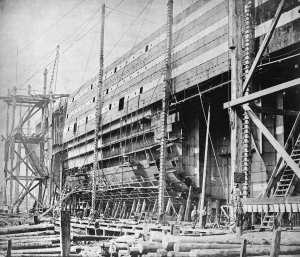
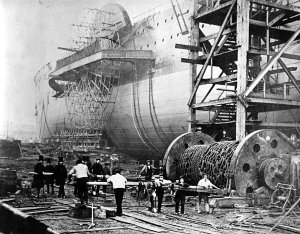
left side: Construction of Great Eastern, August 18, 1855
right side: Great Eastern before launch in 1858
She had sail, paddle and screw propulsion. The paddle-wheels were 17 m (56 ft) in diameter and the four-bladed screw-propeller was 7.3 m (24 ft) across. The power came from four steam engines for the paddles and an additional engine for the propeller. Total power was estimated at 6 MW (8,000 hp).
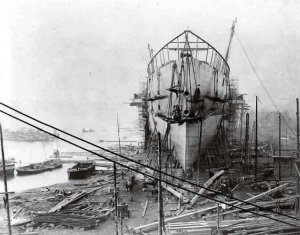
She also had six masts (said to be named after the days of a week – Monday being the fore mast and Saturday the spanker mast), providing space for 1,686 square metres (18,150 sq ft) of sails (7 gaff and max. 9 (usually 4) square sails), rigged similar to a topsail schooner with a main gaff sail (fore-and-aft sail) on each mast, one "jib" on the fore mast and three square sails on masts no. 2 and no. 3 (Tuesday & Wednesday); for a time mast no. 4 was also fitted with three yards. In later years, some of the yards were removed. According to some sources[who?] she would have carried 5,435 square metres (58,500 sq ft). This amount of canvas is obviously too much for seven fore-and-aft sails and max. 9 square sails. This (larger) figure of sail area lies only a few square metres below that the famous Flying P-Liner Preußen carried – with her five full-rigged masts of 30 square sails and a lot of stay sails. Setting sails turned out to be unusable at the same time as the paddles and screw were under steam, because the hot exhaust from the five (later four) funnels would set them on fire. Her maximum speed was 24 km/h (13 knots).
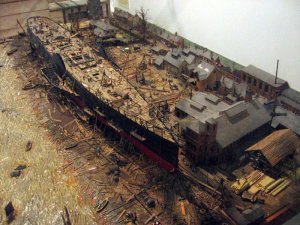
diorama model of the Great Eastern construction yard
Launch
Brunel had hoped to conduct the launch with a minimum of publicity but many thousands of spectators had heard of it and occupied vantage points all round the yard. He was also dismayed to discover that the Eastern Company's directors had sold 3,000 tickets for spectators to enter the shipyard.
As he was preparing for the launch some of the directors joined him on the rostrum with a list of names for the ship. On being asked which he preferred, Brunel replied "Call her Tom Thumb if you like". At 12:30 pm Henrietta (daughter of a major fundraiser for the ship, Henry Thomas Hope) christened the ship Leviathan much to everyone's surprise since she was commonly known as Great Eastern; her name subsequently changed back to Great Eastern in July 1858.
The launch, however, failed, as the steam winches and manual capstans used to haul the ship towards the water were not up to the job.
Brunel made another attempt on the 19th and again on the 28th, this time using hydraulic rams to move the ship, but these too proved inadequate. The ship was finally launched sideways at 1:42pm on 31 January 1858, aided by an unusually high tide and strong winds and using more powerful hydraulic rams supplied by the then-new Tangye company of Birmingham, the association with such a famous project giving a useful fillip to the fledgling company.
She was 211 m (692 ft) long, 25 m (82 ft) wide, with a draft of 6.1 m (20 ft) unloaded and 9.1 m (30 ft) fully laden, and displaced 32,000 tons fully loaded. In comparison, SS Persia, launched in 1856, was 119 m (390 ft) long with a 14 m (46 ft) beam.
The site of launch is still partly visible these days next to Burrell's Wharf on the Isle of Dogs.
Fitting out
The launch of the ship cost £170,000, a third of Brunel's estimate for the entire vessel, and it had yet to be fitted out. It was difficult to get any more money from the Eastern Company's investors as the company was close to bankruptcy. To prevent this from happening, a new company was formed, the "Great Ship Company", with capital of £340,000. They bought the ship for £160,000, which left enough funds for fitting her out. The Eastern Company's shareholders were given the market value of their £20 shares (£2 10s) towards payment for shares in the new company and the Eastern Steam Navigation Company entered liquidation.
Tenders were invited for fitting the ship out, and two were received – one from Wigram and Lucas for £142,000, and the other from John Scott Russell for £125,000. Brunel had taken a long holiday on medical advice and was absent when the contract was awarded to Scott Russell. The work was begun in January 1859, and was completed by August.
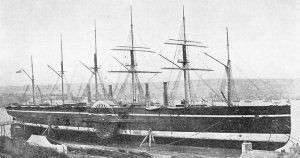
A CONTEMPORARY PHOTOGRAPH OF THE GREAT EASTERN beached for examination. Her original paddle wheels were 56 feet in diameter and weighed 90 tons. These enormous wheels were torn off during a gale in the Atlantic in 1861. They were replaced with stronger paddles 50 feet in diameter. The paddle engines indicated 3,411 horse-power and drove the Great Eastern at 7¼ knots on trial.
Maiden Voyage
The maiden voyage of the vessel, which started on September 6th of 1859, was marked by an unfortunate incident. As the Great Eastern moved into the English Channel, a huge explosion rocked the vessel and one of the funnels was blown off. Six men were killed and nearly as many were seriously injured. The explosion was caused when feed water pipes for the boilers which ran around the funnel to cool it and pre-heat the water had been accidentally closed off. As the funnel warmed the water in the pipes eventually it turned to steam, expanded, and the pipes, not designed to hold back that kind of pressure, gave way.
The ship was not in danger of sinking, however, and the voyage continued to Weymouth, where repairs were made.
Burnel, for health reasons, was not aboard the ship when it made its maiden voyage. A heavy smoker, he suffered a stroke in 1859 and died just before the ship made its first trans-Atlantic trip.
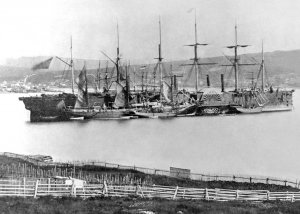
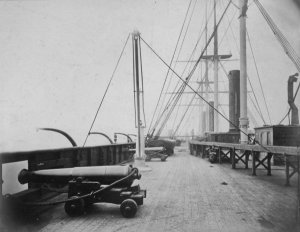
left side: Great Eastern at Heart's Content, July 1866
right side: The deck of Great Eastern in 1865
Though the ship was designed for voyages to the Far East, it turned out that there was never the amount of traffic going in that direction to support its operation. Instead, from 1860 through 1863, she was put into trans-atlantic service between England and the United States. However, the competition was so stiff the Great Ship Company never became profitable and they decided to sell the ship in 1864.
Several attempts were made to sell the ship before it was bought by the newly-formed Great Eastern Steamship Company. Instead of putting the ship back into passenger service, however, the owners had another idea. They chartered it to Telegraph Construction and Maintenance Company and retro-fitted it to lay undersea telegraph cables. It was in this new role that the Great Eastern would have its most outstanding successes.
Laying the Atlantic Cable
In 1837 electrical telegraphs had been developed independently in both Europe and in North America. Within two decades both continents were crisscrossed by wires connecting almost all major cities, allowing same day communications between almost any urban location on those continents. Communications between Europe and North America, however, were still limited by the length of time it took a ship carrying a message to cross the seas: At least 10 days.
The first attempt to lay a telegraph cable across the Atlantic was completed in 1858. Unfortunately because of poor quality materials, the cable stopped functioning after three weeks. However, this did prove that such a plan was viable and in a new effort, using the refitted Great Eastern was started.
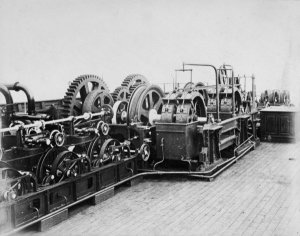
Cable laying machinery installed on Great Eastern
To this end one of the funnels was removed along with some boilers. Many of the staterooms were also gutted and large open topped tanks, designed to hold 2,300 nautical miles of coiled cable, were installed.
In July of 1865, Great Eastern left Valentia Island, Ireland, headed for Canada. All went well for 1,200 miles, when suddenly the cable snapped and the end dropped into the sea. Many attempts were made to use grappling hooks to capture it again, but they all failed. An attempt to lay another cable was made in 1866. This time the Great Eastern set the cable without incident and on July 27th, 1866, arrived at the tiny fishing village in Newfoundland called Heart's Content. The ship managed to lay an average of 120 miles of cable a day.
Immediately after laying the new cable the ship went back to sea and made another attempt at recovering the cable lost in 1865. This time the crew was successful in recovering it. On board the Great Eastern, the old cable was spliced with a new one. Then the ship headed back to Hearts Content laying the 2nd cable. By September 8th a second cable was finished, ensuring that from that day forward the North American and European continents would be linked by telegraph.
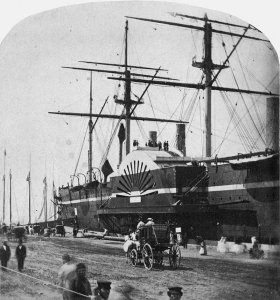
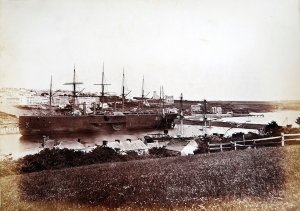
left side: Berthed at New York, 1860
right side: Great Eastern harboured in Milford Haven, 1870s
Break up
The ship continued laying submerged cables until 1870. Attempts after that were made to put her back into passenger service, but this failed. For a few years she was used as a showboat, a floating concert hall and gymnasium, but eventually in 1888 she was scrapped. A sad end for a noble ship with a design that was far ahead of its time.
An early example of breaking-up a structure by use of a wrecking ball, she was scrapped at New Ferry on the River Mersey by Henry Bath & Son Ltd in 1889–1890 – it took 18 months to take her apart. At the time Everton Football Club were looking for a flagpole for their Anfield ground, and consequently purchased her top mast. It still stands there today at the ground - now owned by Liverpool Football Club (formed 1892), at the Kop end.
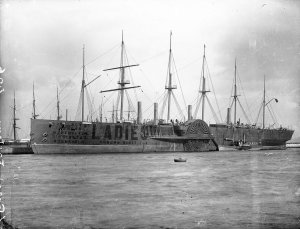
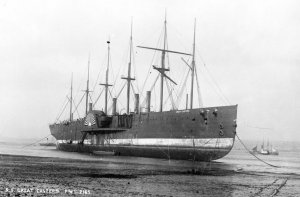
left side: Great Eastern as a floating billboard in Dublin, 1880s
right side: Great Eastern beached for breaking up
data from several sources:
https://en.wikipedia.org/wiki/SS_Great_Eastern
http://www.shippingwondersoftheworld.com/great-eastern.html
https://www.google.at/search?q=grea...alAKHQ8kARAQ_AUICigB&biw=1918&bih=900#imgrc=_
Book "Brunel´s Ships" by Denis Griffiths
Her length of 692 feet or 211 m was only surpassed in 1899 by the 705-foot (215 m) 17,274-gross-ton RMS Oceanic,
and her gross tonnage of 18,915 was only surpassed in 1901 by the 701-foot (214 m) 21,035-gross-ton RMS Celtic.
The ship's five funnels were rare. These were later reduced to four.
Brunel knew her affectionately as the "Great Babe". He died in 1859 shortly after her ill-fated maiden voyage, during which she was damaged by an explosion. After repairs, she plied for several years as a passenger liner between Britain and North America before being converted to a cable-laying ship and laying the first lasting transatlantic telegraph cable in 1866.[4] Finishing her life as a floating music hall and advertising hoarding (for the famous department store Lewis's) in Liverpool, she was broken up on Merseyside in 1889.

The famous Robert Howlett photo of Isambard Kingdom Brunel against the launching chains of Great Eastern at Millwall in 1857.

size comparison of the Brunel´s Ships
Concept
After his success in pioneering steam travel to North America with Great Western and Great Britain, Brunel turned his attention to longer voyages as far as Australia and realised the potential of a ship that could travel round the world without the need of refuelling.
On 25 March 1852, Brunel made a sketch of a steamship in his diary and wrote beneath it: "Say 600 ft x 65 ft x 30 ft" (180 m x 20 m x 9.1 m). These measurements were six times larger by volume than any ship afloat; such a large vessel would benefit from economies of scale and would be both fast and economical, requiring fewer crew than the equivalent tonnage made up of smaller ships. Brunel realised that the ship would need more than one propulsion system; since twin screws were still very much experimental, he settled on a combination of a single screw and paddle wheels, with auxiliary sail power. Using paddle wheels meant that the ship would be able to reach Calcutta, where the Hooghly River was too shallow for screws.
Brunel showed his idea to John Scott Russell, an experienced naval architect and ship builder whom he had first met at the Great Exhibition. Scott Russell examined Brunel's plan and made his own calculations as to the ship's feasibility. He calculated that it would have a displacement of 20,000 tons and would require 8,500 horsepower (6,300 kW) to achieve 14 knots (26 km/h), but believed it was possible. At Scott Russell's suggestion, they approached the directors of the Eastern Steam Navigation Company.


Sectional plan of Great Eastern


1854–1859: Construction to maiden voyage
Although Brunel had estimated the cost of building the ship at £500,000, Scott Russell offered a very low tender of £377,200: £275,200 for the hull, £60,000 for the screw engines and boilers, and £42,000 for the paddle engines and boilers. Scott Russell even offered to reduce the tender to £258,000 if an order for a sister ship was placed at the same time. Brunel accepted Scott Russell's tender in May 1853, without questioning it; Scott Russell was a highly skilled shipbuilder and Brunel would accept an estimate from such an esteemed colleague without question.
In the spring of 1854 work could at last begin. The first problem to arise was where the ship was to be built. Scott Russell's contract stipulated that it was to be built in a dock, but Russell quoted a price of £8–10,000 to build the necessary dock and so this part of the scheme was abandoned, partly due to the cost and also to the difficulty of finding a suitable site for the dock. The idea of a normal stern first launch was also rejected because of the great length of the vessel, also because to provide the right launch angle the bow of the ship would have to be raised 40 feet (12 m) in the air. Eventually it was decided to build the ship sideways to the river and use a mechanical slip designed by Brunel for the launch. Later the mechanical design was dropped on the grounds of cost, although the sideways plan remained.
Having decided on a sideways launch, a suitable site had to be found, as Scott Russell's Millwall, London, yard was too small. The adjacent yard belonging to David Napier was empty, available and suitable, so it was leased and a railway line constructed between the two yards for moving materials. The site of the launch is still visible on the Isle of Dogs. Part of the slipway has been preserved on the waterfront, while at low tide, more of the slipway can be seen on the Thames foreshore. The remains of the slipways, and other structures associated with the launch of the SS Great Eastern, have recently been surveyed by the Thames Discovery Programme, a community project recording the archaeology of the Thames intertidal zone in London.
Great Eastern's keel was laid down on 1 May 1854. The hull was an all-iron construction, a double hull of 19 mm (0.75 in) wrought iron in 0.86 metres (2 feet 10 inches) plates with ribs every 1.8 m (5.9 ft). Internally, the hull was divided by two 107 m (351 ft) long, 18 m (59 ft) high, longitudinal bulkheads and further transverse bulkheads dividing the ship into nineteen compartments. Great Eastern was the first ship to incorporate the double-skinned hull, a feature which would not be seen again in a ship for several decades, but which is now compulsory for reasons of safety.


left side: Construction of Great Eastern, August 18, 1855
right side: Great Eastern before launch in 1858
She had sail, paddle and screw propulsion. The paddle-wheels were 17 m (56 ft) in diameter and the four-bladed screw-propeller was 7.3 m (24 ft) across. The power came from four steam engines for the paddles and an additional engine for the propeller. Total power was estimated at 6 MW (8,000 hp).

She also had six masts (said to be named after the days of a week – Monday being the fore mast and Saturday the spanker mast), providing space for 1,686 square metres (18,150 sq ft) of sails (7 gaff and max. 9 (usually 4) square sails), rigged similar to a topsail schooner with a main gaff sail (fore-and-aft sail) on each mast, one "jib" on the fore mast and three square sails on masts no. 2 and no. 3 (Tuesday & Wednesday); for a time mast no. 4 was also fitted with three yards. In later years, some of the yards were removed. According to some sources[who?] she would have carried 5,435 square metres (58,500 sq ft). This amount of canvas is obviously too much for seven fore-and-aft sails and max. 9 square sails. This (larger) figure of sail area lies only a few square metres below that the famous Flying P-Liner Preußen carried – with her five full-rigged masts of 30 square sails and a lot of stay sails. Setting sails turned out to be unusable at the same time as the paddles and screw were under steam, because the hot exhaust from the five (later four) funnels would set them on fire. Her maximum speed was 24 km/h (13 knots).

diorama model of the Great Eastern construction yard
Launch
Brunel had hoped to conduct the launch with a minimum of publicity but many thousands of spectators had heard of it and occupied vantage points all round the yard. He was also dismayed to discover that the Eastern Company's directors had sold 3,000 tickets for spectators to enter the shipyard.
As he was preparing for the launch some of the directors joined him on the rostrum with a list of names for the ship. On being asked which he preferred, Brunel replied "Call her Tom Thumb if you like". At 12:30 pm Henrietta (daughter of a major fundraiser for the ship, Henry Thomas Hope) christened the ship Leviathan much to everyone's surprise since she was commonly known as Great Eastern; her name subsequently changed back to Great Eastern in July 1858.
The launch, however, failed, as the steam winches and manual capstans used to haul the ship towards the water were not up to the job.
Brunel made another attempt on the 19th and again on the 28th, this time using hydraulic rams to move the ship, but these too proved inadequate. The ship was finally launched sideways at 1:42pm on 31 January 1858, aided by an unusually high tide and strong winds and using more powerful hydraulic rams supplied by the then-new Tangye company of Birmingham, the association with such a famous project giving a useful fillip to the fledgling company.
She was 211 m (692 ft) long, 25 m (82 ft) wide, with a draft of 6.1 m (20 ft) unloaded and 9.1 m (30 ft) fully laden, and displaced 32,000 tons fully loaded. In comparison, SS Persia, launched in 1856, was 119 m (390 ft) long with a 14 m (46 ft) beam.
The site of launch is still partly visible these days next to Burrell's Wharf on the Isle of Dogs.
Fitting out
The launch of the ship cost £170,000, a third of Brunel's estimate for the entire vessel, and it had yet to be fitted out. It was difficult to get any more money from the Eastern Company's investors as the company was close to bankruptcy. To prevent this from happening, a new company was formed, the "Great Ship Company", with capital of £340,000. They bought the ship for £160,000, which left enough funds for fitting her out. The Eastern Company's shareholders were given the market value of their £20 shares (£2 10s) towards payment for shares in the new company and the Eastern Steam Navigation Company entered liquidation.
Tenders were invited for fitting the ship out, and two were received – one from Wigram and Lucas for £142,000, and the other from John Scott Russell for £125,000. Brunel had taken a long holiday on medical advice and was absent when the contract was awarded to Scott Russell. The work was begun in January 1859, and was completed by August.

A CONTEMPORARY PHOTOGRAPH OF THE GREAT EASTERN beached for examination. Her original paddle wheels were 56 feet in diameter and weighed 90 tons. These enormous wheels were torn off during a gale in the Atlantic in 1861. They were replaced with stronger paddles 50 feet in diameter. The paddle engines indicated 3,411 horse-power and drove the Great Eastern at 7¼ knots on trial.
Maiden Voyage

The maiden voyage of the vessel, which started on September 6th of 1859, was marked by an unfortunate incident. As the Great Eastern moved into the English Channel, a huge explosion rocked the vessel and one of the funnels was blown off. Six men were killed and nearly as many were seriously injured. The explosion was caused when feed water pipes for the boilers which ran around the funnel to cool it and pre-heat the water had been accidentally closed off. As the funnel warmed the water in the pipes eventually it turned to steam, expanded, and the pipes, not designed to hold back that kind of pressure, gave way.
The ship was not in danger of sinking, however, and the voyage continued to Weymouth, where repairs were made.
Burnel, for health reasons, was not aboard the ship when it made its maiden voyage. A heavy smoker, he suffered a stroke in 1859 and died just before the ship made its first trans-Atlantic trip.


left side: Great Eastern at Heart's Content, July 1866
right side: The deck of Great Eastern in 1865
Though the ship was designed for voyages to the Far East, it turned out that there was never the amount of traffic going in that direction to support its operation. Instead, from 1860 through 1863, she was put into trans-atlantic service between England and the United States. However, the competition was so stiff the Great Ship Company never became profitable and they decided to sell the ship in 1864.
Several attempts were made to sell the ship before it was bought by the newly-formed Great Eastern Steamship Company. Instead of putting the ship back into passenger service, however, the owners had another idea. They chartered it to Telegraph Construction and Maintenance Company and retro-fitted it to lay undersea telegraph cables. It was in this new role that the Great Eastern would have its most outstanding successes.
Laying the Atlantic Cable
In 1837 electrical telegraphs had been developed independently in both Europe and in North America. Within two decades both continents were crisscrossed by wires connecting almost all major cities, allowing same day communications between almost any urban location on those continents. Communications between Europe and North America, however, were still limited by the length of time it took a ship carrying a message to cross the seas: At least 10 days.
The first attempt to lay a telegraph cable across the Atlantic was completed in 1858. Unfortunately because of poor quality materials, the cable stopped functioning after three weeks. However, this did prove that such a plan was viable and in a new effort, using the refitted Great Eastern was started.

Cable laying machinery installed on Great Eastern
To this end one of the funnels was removed along with some boilers. Many of the staterooms were also gutted and large open topped tanks, designed to hold 2,300 nautical miles of coiled cable, were installed.
In July of 1865, Great Eastern left Valentia Island, Ireland, headed for Canada. All went well for 1,200 miles, when suddenly the cable snapped and the end dropped into the sea. Many attempts were made to use grappling hooks to capture it again, but they all failed. An attempt to lay another cable was made in 1866. This time the Great Eastern set the cable without incident and on July 27th, 1866, arrived at the tiny fishing village in Newfoundland called Heart's Content. The ship managed to lay an average of 120 miles of cable a day.
Immediately after laying the new cable the ship went back to sea and made another attempt at recovering the cable lost in 1865. This time the crew was successful in recovering it. On board the Great Eastern, the old cable was spliced with a new one. Then the ship headed back to Hearts Content laying the 2nd cable. By September 8th a second cable was finished, ensuring that from that day forward the North American and European continents would be linked by telegraph.


left side: Berthed at New York, 1860
right side: Great Eastern harboured in Milford Haven, 1870s
Break up
The ship continued laying submerged cables until 1870. Attempts after that were made to put her back into passenger service, but this failed. For a few years she was used as a showboat, a floating concert hall and gymnasium, but eventually in 1888 she was scrapped. A sad end for a noble ship with a design that was far ahead of its time.
An early example of breaking-up a structure by use of a wrecking ball, she was scrapped at New Ferry on the River Mersey by Henry Bath & Son Ltd in 1889–1890 – it took 18 months to take her apart. At the time Everton Football Club were looking for a flagpole for their Anfield ground, and consequently purchased her top mast. It still stands there today at the ground - now owned by Liverpool Football Club (formed 1892), at the Kop end.


left side: Great Eastern as a floating billboard in Dublin, 1880s
right side: Great Eastern beached for breaking up
data from several sources:
https://en.wikipedia.org/wiki/SS_Great_Eastern
http://www.shippingwondersoftheworld.com/great-eastern.html
https://www.google.at/search?q=grea...alAKHQ8kARAQ_AUICigB&biw=1918&bih=900#imgrc=_
Book "Brunel´s Ships" by Denis Griffiths



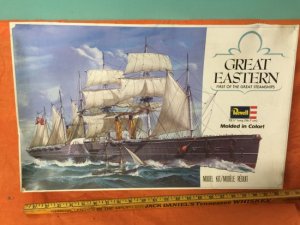
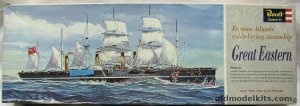
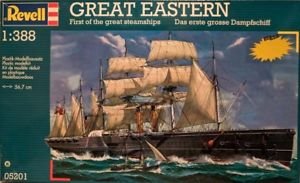
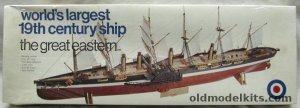
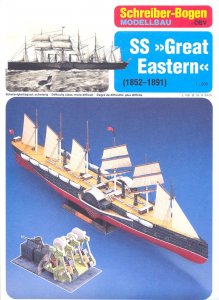
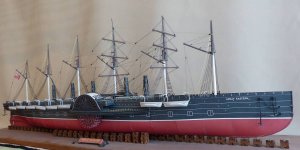
![ge 001a [article].jpg ge 001a [article].jpg](https://shipsofscale.com/sosforums/data/attachments/28/28370-2996a399a9081c8aa4824511b8907f58.jpg?hash=KZajmakIHI)
